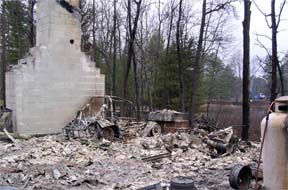Firewise landscaping can save homes from wildfire
Each year, homes are damaged or destroyed by Michigan wildfires, which average more than 8000 per year. Here are some easy tips to protect your home, cabin or cottage.
Homes don’t have to be damaged when wildfires occur. Fire only consumes what burns. It’s simply a matter of removing things that burn from around the house so that a passing wildfire won’t ignite the home or deck.
There are a number of things that homeowners can do to keep wildfire from damaging a structure, such as keeping dead leaves and other combustible material from collecting under a deck. Also, keep leaves from collecting in eave troughs and around landscape shrubbery. During a wildfire, often it is “firebrands”, small pieces of burning vegetation and debris that floats into the air, that start a home on fire. Our research shows that if the firebrands land in dead vegetation, whether it’s under the deck or in the eave troughs, they often ignite the house.

Photo 1. This Michigan home near Grayling was destroyed by a passing wildfire.
Other things homeowners can do to protect the home from wildfire are to create a defensible space around the house which is void of combustible plants. Studies out west show that 85 to 95 percent of homes that survived two major wildfires had 30 to 50 feet of defensible space and fire-resistant roofing such as metal, terracotta tile, or even asphalt. Homeowners can still have a nicely landscaped yard, but using fire-resistant plants can improve their chances of surviving a wildfire intact. MSU Extension Bulletin E2948 Wildfire-Resistant Landscape Plants for Michigan is available at any countyMSU Extension office.
April 17-23 is Wildfire Prevention Week in Michigan. This is a good week to remind us that wildfires do occur in Michigan and that everyone can do their part not only to prevent wildfires, but to protect their homes and buildings.
The Firewise Communities program encourages local solutions for wildfire safety by involving community members with protecting people and property from the risk of fire. The program is supported by the United States Department of Agriculture Forest Service, and the National Fire Protection Association.
Its part of the state’s Michigan Firewise Communities Project, and was funded through the United States Department of Agriculture Forest Service grant.



 Print
Print Email
Email


